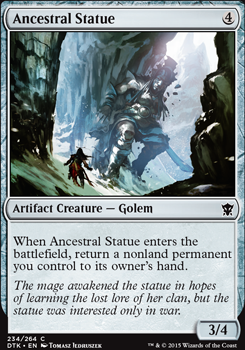Creature (42)
-
1x
Ancestral Statue

-
1x
Arbor Elf

- 1x Bane of Progress
- 1x Barrin, Master Wizard
-
1x
Beast Whisperer

-
1x
Beastcaller Savant

-
1x
Birds of Paradise

-
1x
Bloom Tender

-
1x
Bond Beetle

-
1x
Cloud of Faeries

-
1x
Consecrated Sphinx

-
1x
Destiny Spinner

- 1x Dockside Extortionist
-
1x
Elvish Mystic

- 1x Elvish Spirit Guide
-
1x
Eternal Witness

-
1x
Fauna Shaman

-
1x
Fyndhorn Elves

-
1x
Generous Patron

- 1x Gilded Drake
-
1x
Imperial Recruiter

-
1x
Kiri-Onna

-
1x
Llanowar Elves

- 1x Loyal Drake
-
1x
Mulldrifter

-
1x
Painter's Servant

-
1x
Peregrine Drake

-
1x
Phantasmal Image

-
1x
Phyrexian Metamorph

-
1x
Priest of Titania

-
1x
Prowling Serpopard

-
1x
Raven Familiar

-
1x
Rishkar, Peema Renegade

-
1x
Siren Stormtamer

-
1x
Slithermuse

-
1x
Spellseeker

-
1x
Spellskite

-
1x
Sylvan Safekeeper

- 1x Tinder Wall
-
1x
Walking Ballista

-
1x
Wall of Roots

-
1x
Wild Cantor

Land (30)
-
1x
Ancient Ziggurat

-
1x
Arid Mesa

-
1x
Bloodstained Mire

-
1x
Botanical Sanctum

-
1x
Breeding Pool

-
1x
City of Brass

-
1x
Command Tower

-
1x
Exotic Orchard

-
1x
Fiery Islet

-
1x
Flooded Strand

- 1x Forest
-
1x
Gaea's Cradle

- 1x Island
-
1x
Mana Confluence

-
1x
Misty Rainforest

-
1x
Polluted Delta

-
1x
Reflecting Pool

-
1x
Scalding Tarn

-
1x
Steam Vents

-
1x
Stomping Ground

- 1x Taiga
-
1x
Tarnished Citadel

-
1x
Thran Quarry

- 1x Tropical Island
-
1x
Verdant Catacombs

- 1x Volcanic Island
-
1x
Waterlogged Grove

-
1x
Windswept Heath

-
1x
Wooded Foothills

-
1x
Yavimaya Coast

Artifact (4)
Commander (1)
Instant (12)
-
1x
Brainstorm

-
1x
Chord of Calling

-
1x
Crop Rotation

- 1x Deflecting Swat
- 1x Fierce Guardianship
-
1x
Flusterstorm

-
1x
Mental Misstep

-
1x
Mystical Tutor

-
1x
Pact of Negation

-
1x
Swan Song

-
1x
Veil of Summer

- 1x Worldly Tutor
Enchantment (6)
- 1x Carpet of Flowers
- 1x Mystic Remora
-
1x
Survival of the Fittest

-
1x
Sylvan Library

-
1x
Utopia Sprawl

-
1x
Wild Growth

Sorcery (5)
Maybeboard
Instant (3)
Artifact (1)
Suggestions
Updates Add
Comments
Attention! Complete Comment Tutorial! This annoying message will go away once you do!
Important! Formatting tips — Comment Tutorial — markdown syntax
Please login to comment
| Date added | 8 years |
| Last updated | 3 years |
| Legality | This deck is Commander / EDH legal. |
| Rarity (main - side) | 6 - 0 Mythic Rares 64 - 0 Rares 14 - 0 Uncommons 14 - 0 Commons |
| Cards | 100 |
| Avg. CMC | 2.06 |
| Tokens | Bird 2/2 U, Treasure |
| Folders | Animar, Reference, Animar, Animar, Animar, Interesting Decks, Competitive EDH, Good Animar Lists, edh, Competitive |
| Votes | |
| Ignored suggestions | |
| Shared with | |
| Views |


